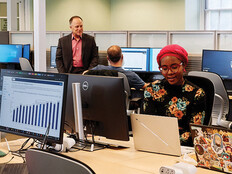Seeing Double: Why Pepperdine Chose Dual-Source Displays for Law Classrooms
The IT department at the Pepperdine University School of Law, in Malibu, Calif., spent months planning and designing a classroom upgrade called the educational technology uplift, or ETU.
To each classroom, Pepperdine added a PC, a Blu-ray player, VGA and HDMI connections for laptops, built-in speakers, a document camera, and a lecture capture system. Each of these is controlled by a touch control panel.
Each classroom has been equipped with two or more projection-display screens. One major decision the School of Law information-services team faced during the planning phase was whether dual-source projection should be used.
The norm for modern classrooms is the use of a single-source display, where there are two screens in a classroom, but the same content is shown on each. For example, a PC with a PowerPoint presentation running is displayed on both of the screens simultaneously.
Alternatively, dual-source projection allows for two unique sources to be shown at the same time. For instance, a DVD can be played in the DVD player on the left display screen while the PC with a PowerPoint presentation running is displayed on the right screen.
The Benefit of Dual-Source Projection
Instructors and presenters don’t lose valuable lecture time switching between sources. Setting up the sources before the lesson so that they are ready to go results in a seamless flow of content. Professors can speak about the content on the left screen and then seamlessly flow to the content on the right screen. Otherwise, the instructor would need to stop midlesson to disable the source that is currently showing on the screens and enable the second source. For instructors who are not tech savvy, this switching of content midlesson could prove to be both cumbersome and time consuming.
Another benefit to the dual-source projection is that instructors still have the option to display a single source on both projection screens. Displaying a single-source on both screens is recommended for those instructors who are using only one piece of content, such as a video, to aid in their lecture. Using both projection screens with the same source displayed will increase the sight lines of the classroom.
Pepperdine University School of Law’s decision to use dual-source projection has been beneficial so far. In comparison to past semesters, the Fall 2013 term has shown an increase in the use of educational technology. In addition, the development of an easy-to-use control interface has resulted in instructors being autonomous in their course setup, relying less on support from the information services department.








